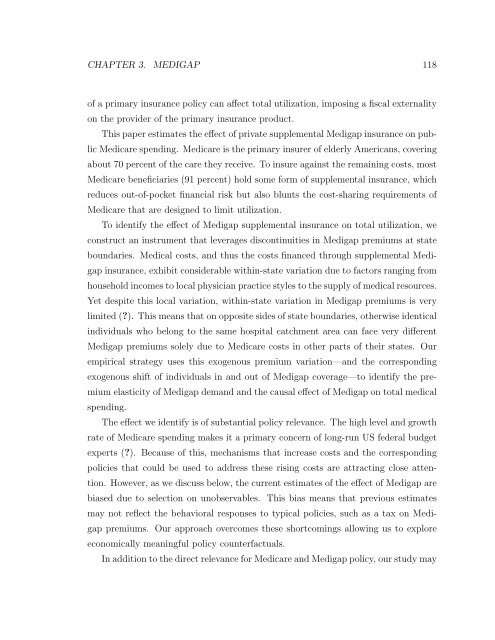essays in public finance and industrial organization a dissertation ...
essays in public finance and industrial organization a dissertation ...
essays in public finance and industrial organization a dissertation ...
Create successful ePaper yourself
Turn your PDF publications into a flip-book with our unique Google optimized e-Paper software.
CHAPTER 3. MEDIGAP 118<br />
of a primary <strong>in</strong>surance policy can affect total utilization, impos<strong>in</strong>g a fiscal externality<br />
on the provider of the primary <strong>in</strong>surance product.<br />
This paper estimates the effect of private supplemental Medigap <strong>in</strong>surance on pub-<br />
lic Medicare spend<strong>in</strong>g. Medicare is the primary <strong>in</strong>surer of elderly Americans, cover<strong>in</strong>g<br />
about 70 percent of the care they receive. To <strong>in</strong>sure aga<strong>in</strong>st the rema<strong>in</strong><strong>in</strong>g costs, most<br />
Medicare beneficiaries (91 percent) hold some form of supplemental <strong>in</strong>surance, which<br />
reduces out-of-pocket f<strong>in</strong>ancial risk but also blunts the cost-shar<strong>in</strong>g requirements of<br />
Medicare that are designed to limit utilization.<br />
To identify the effect of Medigap supplemental <strong>in</strong>surance on total utilization, we<br />
construct an <strong>in</strong>strument that leverages discont<strong>in</strong>uities <strong>in</strong> Medigap premiums at state<br />
boundaries. Medical costs, <strong>and</strong> thus the costs f<strong>in</strong>anced through supplemental Medi-<br />
gap <strong>in</strong>surance, exhibit considerable with<strong>in</strong>-state variation due to factors rang<strong>in</strong>g from<br />
household <strong>in</strong>comes to local physician practice styles to the supply of medical resources.<br />
Yet despite this local variation, with<strong>in</strong>-state variation <strong>in</strong> Medigap premiums is very<br />
limited (?). This means that on opposite sides of state boundaries, otherwise identical<br />
<strong>in</strong>dividuals who belong to the same hospital catchment area can face very different<br />
Medigap premiums solely due to Medicare costs <strong>in</strong> other parts of their states. Our<br />
empirical strategy uses this exogenous premium variation—<strong>and</strong> the correspond<strong>in</strong>g<br />
exogenous shift of <strong>in</strong>dividuals <strong>in</strong> <strong>and</strong> out of Medigap coverage—to identify the pre-<br />
mium elasticity of Medigap dem<strong>and</strong> <strong>and</strong> the causal effect of Medigap on total medical<br />
spend<strong>in</strong>g.<br />
The effect we identify is of substantial policy relevance. The high level <strong>and</strong> growth<br />
rate of Medicare spend<strong>in</strong>g makes it a primary concern of long-run US federal budget<br />
experts (?). Because of this, mechanisms that <strong>in</strong>crease costs <strong>and</strong> the correspond<strong>in</strong>g<br />
policies that could be used to address these ris<strong>in</strong>g costs are attract<strong>in</strong>g close atten-<br />
tion. However, as we discuss below, the current estimates of the effect of Medigap are<br />
biased due to selection on unobservables. This bias means that previous estimates<br />
may not reflect the behavioral responses to typical policies, such as a tax on Medi-<br />
gap premiums. Our approach overcomes these shortcom<strong>in</strong>gs allow<strong>in</strong>g us to explore<br />
economically mean<strong>in</strong>gful policy counterfactuals.<br />
In addition to the direct relevance for Medicare <strong>and</strong> Medigap policy, our study may










